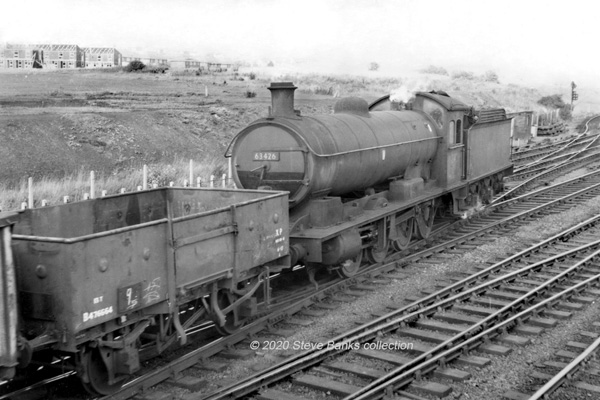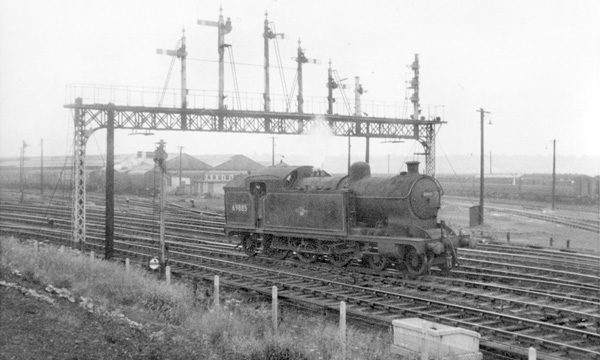Waterloo Junction and Neville Hill East

The OS 25in map for 1933-35 shows Waterloo Junction. This is the point where, coming from the north, the four-track to Leeds City started. Waterloo Carriage Sheds and sidings are prominent, and to the lower left, the branch to Waterloo Main Colliery. Source: Ordnance Survey, National Library of Scotland.
Click on the image for an enlargement

A detail view with the signal box that was originally named simply "Waterloo", until BR renamed it "Neville Hill East". On the map the initials "SB" were moved aside because of a signal post - the small rectangle is the lamp hut. The signal gantries are identified "S.Br". Source: Ordnance Survey, National Library of Scotland.
Click on the image for an enlargement
New additions placed here temporarily
Waterloo Carriage Sidings workings

An undated view from c1965 as Holbeck's Fairburn 2-6-4T No.42052 (whose running number on the side is barely legible) pauses in the sidings during an exchange of LMR NPCS. Lights being carried are for Code C NPCS Parcels etc. Photo: Author's collection.
Click on the image for an enlargement

And sets off back to the LMR with an ex-SR BV. Photo: Author's collection.
Click on the image for an enlargement

A broadside view of the loco. Photo: Author's collection.
Click on the image for an enlargement

And passes Neville Hill East signal box. Photo: Author's collection.
Click on the image for an enlargement

After Neville Hill lost its A3s it would borrow passenger locos from Farnley for excursions and in this undated view from c1965, "Jubilee" Class 45647 Sturdee is taking the empty coaches (all BR Mk.1 as far as I can see) from the Carriage Sidings down the hill to the station. Photo: Author's collection.
Click on the image for an enlargement
A general view taken on Sunday 6th July 1958. It's a miserable day and the photographer's camera was not the best but shows Waterloo Carriage Shed and sidings and one of the signal gantries still carrying ex-NER slotted post signals.
The loco, ex-NER A8 4-6-2T No. 69885 is, alas, not very clear. Its allocation had oscillated between Scarborough and Neville Hill and the big Pacific tank was on the point of going back north for the last time. A single light is being carried which suggests a light engine movement. Photo: Ralph Thurlow.
Click on the image for an enlargement

Riddles 2-6-0 No 77002 (Stourton) pauses in front of the Carriage Sheds c1963-64 carrying light engine lights. Photo: Trevor Spindler. Click on the image for an enlargement

A later view view from 22nd September 1965 taken from the signal box showing one of the home shed's Q6 0-8-0s, No 63426, serving as Cross Pilot and propelling wagons between Up and Down yards.
The end wagon is a BR steel-bodied 13T High Goods Wagon (Shildon 1951 No B476664). In the distance, somewhat washed out by a bright sun, a new housing estate is being built. Photo: D.Hardy. Click on the image for an enlargement
Trains passing the junction

It's 7.16pm on a sunny August Bank Holiday evening in 1956 although there's a light haze in the air as A4 No 60016 Silver King passes Neville Hill East signal box on the six-mile climb out of Leeds City towards Garforth, which begins easily but steepens to 1:160. It has a holiday relief to the 5pm Liverpool-Newcastle express. The loco was long-lived at Gateshead and may have worked in with a similar relief earlier in the day. A4s were known at Leeds City and Neville Hill but not exactly common.
The formation had been provided by the LMR and is made up smartly with ex-LMS P.III Stanier coaches, except for the strengthener added behind the tender, which is an older P.1 composite with the original panelling modernised.
The signal gantry is worth a closer look for six of the arms are still ex-NER slotted post lower quadrants. One appears to be "off" a little droopily. The upper quadrant "double peg" is for the main line into Leeds and was probably for the train in the next picture. 7th August 1956. Photo: Ralph Thurlow.
Click on the image for an enlargement

There was another gantry to the east not far from the one in the picture above. It's 7.25pm, nine minutes later, looking the other way as an express coasts down the grade behind D49 No 62761 The Derwent. This loco had been transferred from Starbeck for the back end of the summer season and may have been heading a train from Scarborough, perhaps a relief or an excursion for among the gangwayed carriages there is a 51'1 1/2" semi-corridor lavatory composite still in varnished teak livery (as is another coach further back). None of the carriages is especially new, the turnbuckle trussing dating them from the 1920s and early '30s, the kind of stuff that all carriage sheds kept for busy times.
On this gantry one signal was still ex-NER slotted post lower quadrant and it protected the eastbound main line. It was the only one left and it too is rather droopily "off", in this case for the train in the next picture. 7th August 1956. Photo: author's collection.
Click on the image for an enlargement

Two minutes later sees the normally timetabled 5pm Liverpool-Newcastle come by and the ER formation, made up with Thompson and BR Mk.1 coaches. Normally hauled by an A3 and No 60083 Sir Visto (Gateshead) is in charge. It appears that a second loco may have been required and Scarborough's D49 No. 62751 The Albrighton was added, although it may simply have been working back to York at the end of a busy day. 7th August 1956. Photo: Ralph Thurlow.
Click on the image for an enlargement

The final picture in this group was captured on Saturday 27th June 1959 at 5.49pm and shows what is captioned as the 8-coach 5.43pm Leeds City-Scarborough. It's a pretty smart set that had already been painted in BR maroon. In charge is B1 No 61062 which, when built, had been delivered to Neville Hill but was now a York loco.
Note how much the signal gantry has been modernised and simplified yet one ex-NER slotted post lower quadrant - for the Up Main line - was newly installed. The tender loco in the background is a J39 serving as Carriage Shed Pilot. Photo: Ralph Thurlow.
Click on the image for an enlargement

A picture from the early 1960s when Neville Hill still had four A3s shows an unidentified A3 on an express heading towards York. It's an enthusiast's picture, into the light and not too sharp, but it's a rare view of the signal box. Photo: T. Spindler.
Eric Oates has spotted that, in my original caption, it could not have been Trigo because of the GNR-style tender. So that rules out all the 55H A3s and as only "600" can be made out, I am stuck!
Click on the image for an enlargement



